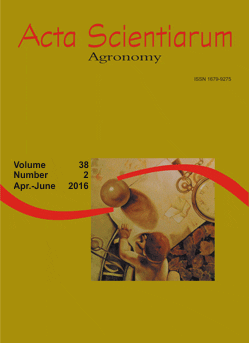<b>Phosphorus uptake and use efficiency of different cotton cultivars in savannah soil (Acrisol)
Resumo
Low soil phosphorus (P) is a limiting factor for plant growth in the Brazilian savannah, where P diffuses slowly and has a high fixation rate in soil (as Al-P and Fe-P). In this study, we investigated the variation in P uptake by different cotton cultivars grown in savannah soil. We conducted a greenhouse experiment using a fully factorial 2 x 17 randomized design with two P treatments (low P = 20 mg kg-1 and high P = 120 mg kg-1) and 17 cotton cultivars. The plants were potted in Acrisol soil labeled with radioisotope 32P. There was genetic variation in the P use efficiency among the cotton cultivars. The P treatments significantly influenced the dry weight of shoots (DWS), P accumulation, the specific activity of 32P, and the L-value (both the standardized and L-values discounted the P present in the cottonseed). Hierarchical clustering analysis classified the cotton cultivars into distinct, internally homogeneous clusters. Our results suggest that cotton cultivars could be selected to maximize P absorption efficiency in conditions of low plant-available P. The cultivars FMT 523, FM 910 and CNPA GO 2043 were the most responsive to P fertilization, while Barbadense 01, FM 966LL, IPR Jataí, BRS Aroeira and BRS Buriti were most efficient at absorbing plant-available P.
Downloads
DECLARAÇÃO DE ORIGINALIDADE E DIREITOS AUTORAIS
Declaro que o presente artigo é original, não tendo sido submetido à publicação em qualquer outro periódico nacional ou internacional, quer seja em parte ou em sua totalidade.
Os direitos autorais pertencem exclusivamente aos autores. Os direitos de licenciamento utilizados pelo periódico é a licença Creative Commons Attribution 4.0 (CC BY 4.0): são permitidos o compartilhamento (cópia e distribuição do material em qualqer meio ou formato) e adaptação (remix, transformação e criação de material a partir do conteúdo assim licenciado para quaisquer fins, inclusive comerciais.
Recomenda-se a leitura desse link para maiores informações sobre o tema: fornecimento de créditos e referências de forma correta, entre outros detalhes cruciais para uso adequado do material licenciado.




















































